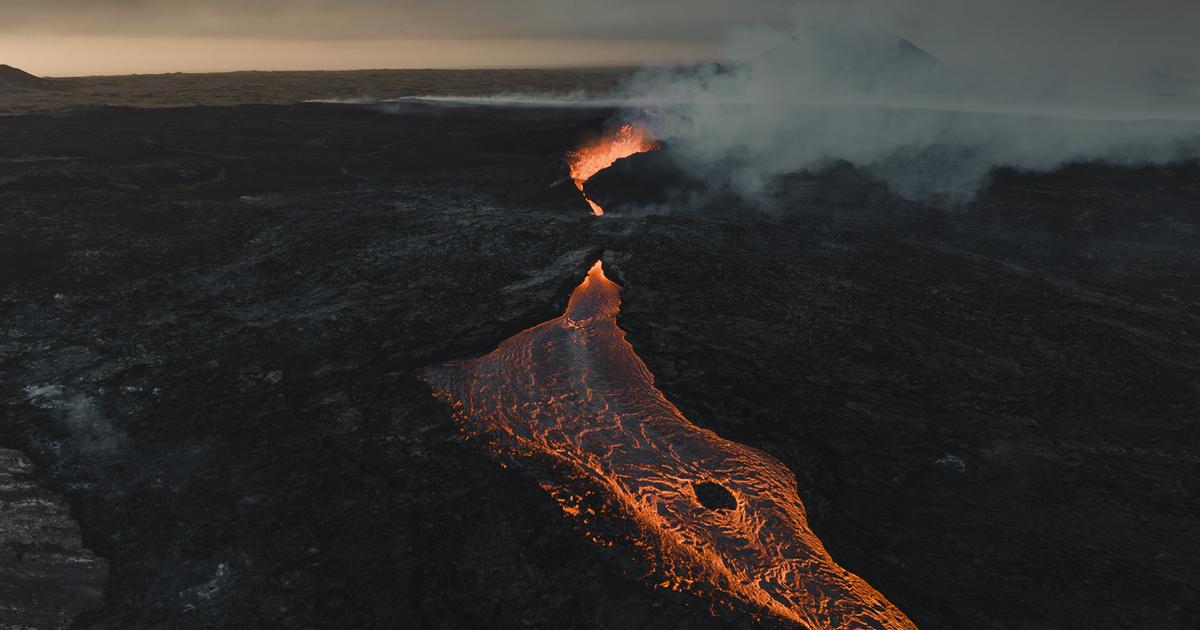On the island of fire and ice, this is the third observed since December 18.
This Thursday, February 8 in the morning, a new volcanic eruption began on the Reykjanes peninsula, in the southwest of Iceland, causing jets of lava towards the sky visible from the capital Reykjavik.
A dream opportunity for photography enthusiasts who wish to venture to the site of the eruption in order to capture, for some, the images of a lifetime.
To discover
Tailor-made trips: discover the offers from our partners
Travel to Iceland: tailor-made tours, hotels and stays from our partners
Already in July 2023, an eruptive fault opened nearly 900 meters to the foot of Mount Litli Hrutur, in the same Reykjanes peninsula.
Our photographer Valentin Pilate, who was present on site, gives his story and advice here.
Photographing an erupting volcano is obviously risky, even if it seems to have become an -almost- general public spectacle in Iceland.
But first, pay attention to the safety and access instructions.
In this case, the opening of the fault near Litli Hrutur was a low-intensity eruption and far from any human activity.
This is why access was possible after around twenty kilometers of walking and supervised by the authorities on site.
Indeed, for this type of eruption which has become common and touristy, police officers and scientists are on site to ensure that the curious, and in this case passionate about the image, keep a good distance from the lava field, gases and naturally the crater where the activity remains the most intense, with the risk of another fault opening at any time.
Once you are installed a good distance from the lava field and therefore
the crater, the serious things begin.
The excitement is there.
We
admire this river of lava which is gaining ground, we feel the earth trembling, we listen to the crater which continually spews jets of lava.
All the
senses are alert.
It’s time to concentrate to get the
best shots.
Which lens to use?
Which box to use?
What objective?
Which drone?
Do I need polarizing filters
?
Which mode to use?
Under what weather conditions?
For these images, I used two bodies equipped with two different lenses in order to achieve wide angle and detail.
Manual mode activated
for complete control of settings (shutter speed - aperture -
ISO).
My first camera, the Canon R5, had a 100-500 f4.5-7.1 so I could reach the crater.
Because we were kept at a good distance from it (between 700 and 800 meters).
No other choice than to equip myself with a telephoto lens to have a clear image and above all to reveal how impressive this pot of lava was.
My second camera was my R6 equipped with a 24-70 f2.8 to integrate this lava field within this large plain of the peninsula.
My drone was the Mavic 3 Pro equipped with an ND filter (8) taking into account
the level of the sun and the settings of the device which, by its basic settings, lets in too much light.
Hence the importance of integrating a polarizing filter on your drone in order to adapt its shutter speed/aperture/ISO accordingly.
Bringing out the lava
The best time to photograph an erupting volcano is from the moment the sun sets.
Concretely, when there is less and less light, so that the lava is very bright and colorful in the images.
Practical advice: as the lava is continually moving, it is important to keep a fast shutter speed (1/200sec minimum) in order to capture all the details without motion blur, regardless of the camera or the drone used.
This implies a large aperture, ideally between f2.8 and f4.5, in order to keep the ISO as low as possible and thus avoid digital noise.
Despite the fact that it can be considerably reduced today in
post-production, it is always more pleasant to start with a clean image than with an image full of defects.
Stay moving
For lovers of long exposure times: naturally equip yourself with a tripod, which can be judicious and artistic by opting for a very wide angle (10-20mm) while being as close as possible to the lava field.
With overcast and windy weather
, you will smooth out your image, the lava as well as the clouds.
Like a beautiful flaming painting.
Last tip, stay moving.
The site of a volcanic eruption is
chaotic and leaves room for many possibilities.
Vary the angles by
getting closer to the lava field as much as possible,
go along it, move away, gain some height if possible on the environment
around you.
Inspiration comes naturally, as this natural phenomenon has impressed and intrigued humans since the dawn of time.
Whether we dream of seeing a volcano erupting or not, everyone's eyes shine on the spot.
Those of dreamer photographers certainly more than others...
In video -
“It was a life goal to see this”: in August 2022, an eruption in a volcanic fissure delights tourists in Iceland.

